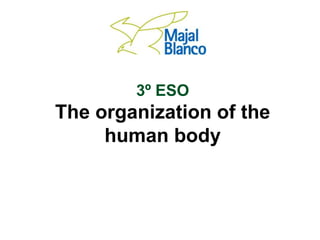
Unit 1. The organisation of the human body.
- 1. 3º ESO The organization of the human body
- 2. Organisation of living matter
- 3. Organisation of living matter Human beings are living things: • Composed of biomolecules (proteins, lipids and carbohydrates) • Made of cells (60 trillions cell). So they are multicellular organisms • Eukaryote cells: these have organelles and DNA enveloped by a cover • They perform the three vital functions: • Nutrition: they feed on other living things (heterotrophic) • Interaction • Reproduction
- 4. Levels of organisation of the human being especializadas de varios tipos Mismo tipo de tejido Distinto tipo de tejido
- 5. Cell Types • Prokaryotic • Eukaryotic
- 6. Characteristics of All Cells • A surrounding membrane • Cytoplasm– cell contents in thick fluid • Control center with DNA (Nucleus)
- 8. Cytoplasm • Viscous fluid containing organelles • components of cytoplasm – Interconnected filaments & fibers – Fluid = cytosol – Organelles (not nucleus) – storage substances
- 9. Nucleus • Control center of cell • Double membrane • Contains – Chromosomes – Nucleolus
- 10. Nuclear Envelope • Separates nucleus from rest of cell • Double membrane • Has pores
- 11. Nucleolus • Most cells have 2 or more • Directs synthesis of RNA • Forms ribosomes
- 12. Rough Endoplasmic Reticulum • Ribosomes attached to surface – Manufacture protiens – Not all ribosomes attached to rough ER • May modify proteins from ribosomes
- 13. Smooth Endoplasmic Reticulum • No attached ribosomes • Has enzymes that help build molecules – Carbohydrates – Lipids
- 14. Golgi Apparatus • Packaging & shipping station of cell
- 16. Lysosomes • Contain digestive enzymes • Functions – Aid in cell renewal – Break down old cell parts – Digests invaders
- 17. Vacuoles • Membrane bound storage sacs • More common in plants than animals • Contents – Water – Food – wastes
- 18. Mitochondria • Break down fuel molecules (cellular respiration) – Glucose – Fatty acids • Release energy – ATP
- 19. Cytoskeleton • Made of proteins • Supports cell shape and function • Keep organelles organized
- 20. Centrosome • Near the nucleus. • Formed by two tubular structures: centrioles (made of proteins) • Coordinate cytoesqueleton movement and cell division
- 21. Exchange with the environment • Cells have to exchange substances to live through its semipermeable membrane: – Diffusion: movement of small molecules from greater to lower concentration. – Osmosis: passage of water from the more diluted to the more concentrated medium – Active transport: movement of substances from lower to greater concentration – Endocytosis: cell sometimes incorporates large particles by membrane collapsing . The opposite process is called exocytosis.
- 22. Cellular differentiation • After fertilization , egg cell begin to divide on identical cells (stem cells) till gastrulation stage on 3rd week Specialised cells (muscle ones for instance): • Makes a particular job. Muscle cells contract and relax to produce movement • Develop a characteristic shape. Muscle cells are usually very long . • There are changes in their cytoplasm .In muscle cells are abundant mitocondria for energy-producing and cytoskeletal filaments . Those 60 trillion cells in a human body have the same nucleus DNA
- 23. Types of tissues Epithelial tissues: cells arranged very closely together • Epithelium tissue Lining the surface of the body (skin and hollow cavities inside the body) • Glandular epitheliumreleases substances with different functions (pancreas and liver). Sometimes form structures called glands (saliva glands) Type of cells Intercellular substance among them
- 24. Types of tissues Connective tissues: supports and/or connects other tissues. Produce a lot of extracellular substances. • Connective tissue Located in the deepest layer of our skin (dermis) and “stuffing” between organs • Adipose tissueenergetic reserve. Thermal insulating. • Bloodtransports nutrients and oxygen • Bone tissuerigid tissue because of mineral salts it contains in its matrix • Cartilaginous tissue protects joints from the bones, and strengthens some structures.
- 25. Types of tissues Muscle tissue • Composed of elongated cells called muscle fibres • These muscle cells contract and relax causing the body to move • Three different muscle tissues: • Striated muscle tissue: contract voluntary (locomotor system) • Smooth muscle tissue: contract involuntary (stomach or intestine) • Cardiac muscle tissue: striated but contract involuntary
- 26. Types of tissues Nervous tissue • Composed of cells called neurons. • Coordinates the functioning of the organism.
- 27. Organ
- 28. Systems Nutrition • Digestive systemPrepares food to be used by cells • Respiratory systemSupplies O2 to the blood and takes away CO2 • Circulatory systemBlood distribute nutrients and oxygen. Picks up waste products • Excretory systemPicks up waste products from blood and discharges them from the body. Regulates wáter content.
- 29. Systems Reproduction • Reproductive system Ensures our survival over time. Involves both, male and female reproductive organs
- 30. Systems Interaction (to internal and external enviroment) • The sensory organs Pick up information and enable the body to adapt and survive • The nervous systemReceives information from outside and inside the body. Coordinates all the body functions • The endocrine systemMade up of glands, special organs that release substances (hormones) to the blood. Different effects on the body. • The skeletal and muscular systems (locomotor system) Formed by bones and muscles respectively. Responsible for a person’s movement.
- 31. Systems Notice that: • The nervous and endocrine systems coordinate all the systems in the body • Sense organs perceive internal and external stimuli • The nervous system sends orders to the organs in order to respond to those stimuli • The endocrine system controls many of the reactions that take place inside cells
